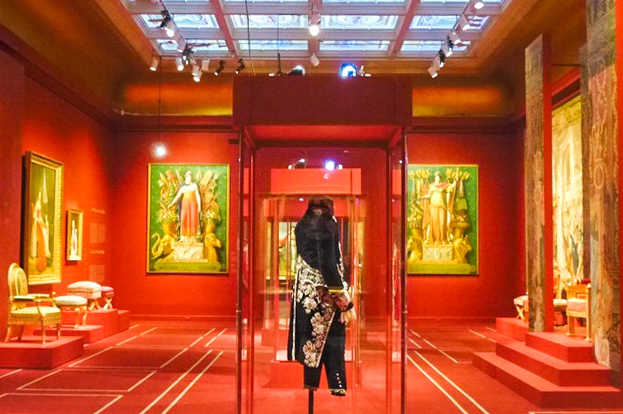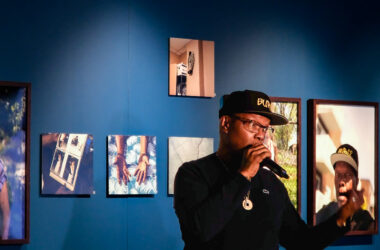The Montreal Museum of Fine Arts (MMFA)’s Napoleon: Art and Court Life in the Imperial Palace offers a scale and quality of artwork exhibited in is immediately reflected upon entering the museum. The second floor of the Michal and Renata Hornstein Pavilion is transformed into a replica of Tulieries Palace under the direction of Sylvain Cordier, curator of Early Decorative Arts.
A project nearly five years in the making, this exhibition was no small undertaking: Guests can peruse roughly 400 artworks and objects derived from the Ben Weider Napoléon Collection, the largest of its kind in North America. The sheer volume and splendour of the assembled works is impressive enough on its own, yet Cordier and Nathalie Bondil, chief curator of the MMFA, have managed to construct a clear chronology to this exhibit, elevating patrons from mere viewers to active participants.
Within Napoléon, two narratives run parallel to one another: Daily life at the Imperial Palace, and the rise and fall of Napoléon Bonaparte. The exhibition invites viewers to draw comparisons between the progression of a day’s labour to the gradual decline of the First Empire. The layout of the exhibition mimics the apartments of the Tuileries, with each room dedicated to one of the six Grand Officers of the household, each of whom helped to construct Bonaparte’s image of power.
Beginning in the Imperial Household, the first room examines how Bonaparte’s public image was disseminated with the help of the Household staff through visual propaganda, marking the start of the Empire. The exhibition then transitions into a room dedicated to the Grand Master of the Imperial Hunt, a not-so-subtle nod to the Napoleonic Wars that plagued Europe during the Empire. This room examines the country life of the French imperial family and its supporting nobles, and how the upper class distracted themselves as young men died en masse across the continent. Through the Grand Chaplaincy, the Grand Marshal, and, ultimately, to Bonaparte’s exile on the island of Elba, the exhibition demonstrates the impressive group effort that went into presenting one man to the world.
In every painting, every crucifix, there is a hidden meaning imbued—that of control and subjugation. As a ruler, Napoléon expertly crafted a royal image that drew from his predecessors of the Ancien Regime and from the Roman Emperors to reinforce his mythic rule. This image, cultivated with the help of a team of advisors, was evident even in Napoléon dress and household decor, like the tableware and furniture. These were exclusively created by the Sèvres Porcelain Manufactory. A simple tea service is elevated with gilded gold, imperial eagles, and patriotic French symbolism of the revolution, such as the fleur de lys. This abject display of wealth enforced Bonaparte’s status as the reigning power in the empire.
Bonaparte’s authority is seen in larger works as well; the Portrait of Napoléon in Ceremonial Robes (1805) by François-Pascal-Simon Gèrard immediately draws the attention of visitors. With its tight composition and Greco-Roman influences, this painting epitomizes the ethos of Napoleon’s cult of personality. The son of a minor noble who quickly rose to military power during the Terror of the French Revolution, Bonaparte established a new dynasty, and quickly expanded his reach to create the largest land empire in 19th century Europe. Propaganda often showed Bonaparte’s military might, and paintings such as that by Gerand were meant to enforce absolutist presence.
Napoléon’s ornate and opulent rooms of deep mahoganies and mauves are filled floor to ceiling with imposing, austere portraits. It’s not difficult to imagine daily life at the Tuileries: A life of hunting, excess, and boredom. The exhibition succeeds at bringing this narrative to life through its inclusion of decorative arts. I found myself in complete awe as I stood beneath the Altar Fixtures for Wedding of Napoléon and Marie-Louise, later for the Chapel at Tuileries (1809). Underneath the silver cross and candle holders, which Georges Rouget detailed in a painting, I realized that the narrative that was presented was no longer a figment of a history textbook. The graphic emotion evoked by such banal objects allows modern viewers to engage in a discourse with the recent past that remains rooted in our contemporary values.
Napoléon: Art and Court Life in the Imperial Palace runs from Feb. 3 to May 6. Tickets are available at https://www.mbam.qc.ca/en/exhibitions/on-view/napoleon/









